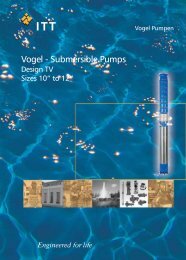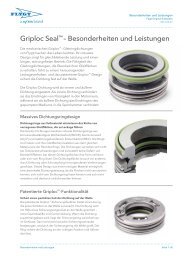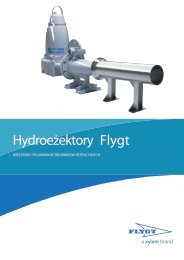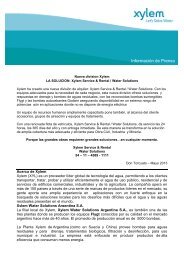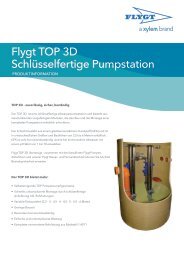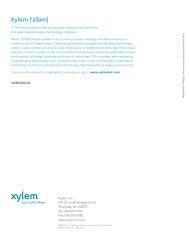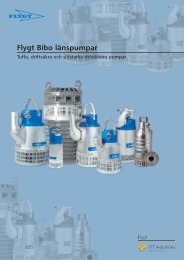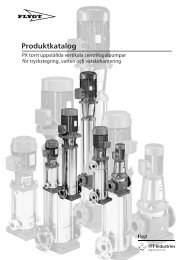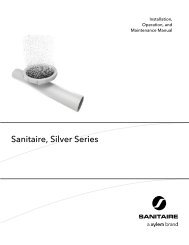Computational fluid dynamics - Flygt
Computational fluid dynamics - Flygt
Computational fluid dynamics - Flygt
You also want an ePaper? Increase the reach of your titles
YUMPU automatically turns print PDFs into web optimized ePapers that Google loves.
Interpreting the CFD results<br />
For a novice, CFD is synonymous with colorful<br />
graphics. It is true that simulation results are often<br />
presented by many colorful plots, but they should<br />
not be taken as abstract art; all lines and colors<br />
have specific meanings. The most commonly used<br />
types of plots in our field are those showing velocity<br />
and pressure. In a three-dimensional flow domain,<br />
the flow field is characterized by a three-dimensional<br />
vector field. Since there is no simple way of<br />
showing such a vector field, several types of plots<br />
are used.<br />
One type of plot uses streamlines, which are curves<br />
that are tangent to velocity vectors. They can be<br />
colored by velocity magnitude so they effectively<br />
convey both direction and magnitude of velocity in<br />
a three-dimensional space.<br />
We initially used CFD for developing turbomachinery:<br />
pump impellers, volutes, mixers and other<br />
hydraulic parts. Currently we can model complete<br />
pumps with rotating impellers or more complex<br />
systems such as pump stations, mixing or aeration<br />
tanks. We promote the use of CFD in designing<br />
pump stations for customer projects for any<br />
non-standard configuration or any large pump station<br />
if the risks involved outweigh the costs of CFD<br />
modeling.<br />
At <strong>Flygt</strong>, we use three different top-ranked CFD<br />
codes: ANSYS Fluent, ANSYS CFX, and CFD++. We<br />
also use other state-of-the-art software for meshing<br />
and postprocessing. To ensure short turnaround<br />
time, most of calculations are done on our own<br />
computer clusters.<br />
Another way of showing the velocity field is to use<br />
cross sections through the flow domain overlaid<br />
with contour maps of velocity magnitude or with velocity<br />
vectors. Usually, several cross-sectional plots<br />
are required to show the three-dimensional characteristics<br />
of the flow.<br />
Besides graphical results, integral parameters<br />
such as flow rates or pressure forces can also be<br />
calculated.<br />
CFD at <strong>Flygt</strong><br />
We pioneered the use of CFD in the pump industry<br />
in the 1980s. All our CFD engineers have solid background<br />
in <strong>fluid</strong> mechanics and vast experience with<br />
real-world hydraulics. This type of expertise is essential<br />
in making accurate and reliable simulations.<br />
It helps throughout the entire modeling process,<br />
from selecting the limits of the model, through developing<br />
computational meshes, using correct numerical<br />
techniques to correctly interpreting the results.<br />
The expertise also comes in handy in finding<br />
effective solutions to any encountered problems.<br />
CFD model of a complete pump with a rotating propeller<br />
(pump housing removed for clarity); colors indicate pressure on<br />
the blades and other internal surfaces.<br />
5



